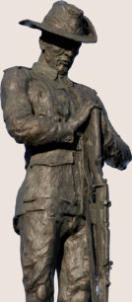Their bodies are buried in peace; but their names liveth for evermore.
Their Duty Done
A tribute to the men and women of the East Gippsland Region who Died
as a result of their participation in World War One : 1914 -1919



2434 Corporal Herbert Storer - Wiseleigh
Killed in Action 11 April 1917
In August 1915, William Storer married Ellen Akers at St Mary’s Catholic Church
in Bairnsdale. William was a sleeper cutter in partnership with Westaway in
Bruthen probably supplying the railway line as it was being constructed. It seems
that his brother Herbert was here in East Gippsland working with him from their
hometown of Carapooee, near St Arnaud. At 21 he enlisted from Bruthen. Before
sailing, he returned to Carapooee where locals presented him with a gold-
mounted watch guard, fountain pen and wallet.
The Persia loaded with the 14
th
Battalion left the same month that William’s
brother married. He was initially at Gallipoli where he tried his hand at
everything, including sapping and had also been through a school for a machine
gunner. He developed jaundice and spent two months on Mudros before being
transferred to a hospital ship and then onto the No. 3 Auxiliary Hospital in Cairo
where he contracted mumps.
Unbeknown to Herbert, his brother Samuel back in Australia had enlisted
and was also on his way to the front. Eventually, in March 1916, he re-joined his
battalion and was promoted to Lance Corporal on 18 May and disembarked at
Marseilles on 8 June 1916. Before the end of the year he would have two visits to
hospital with trench foot, a condition that was to be expected. In a letter to his
parents he stated that he and his brother, Corporal Samuel Storer, had come out
of the trenches near Pozieres safely. It was very wet and muddy. He met George
Torny (his cousin) and he was well after his first short visit. His second visit was
much longer and he wrote home that his brother Sam, who had now transferred
to the 14
th
Battalion, was well when I left France. He never had to go up to the
front line. I am pleased he never had to go up, as nearly all of us got bogged. It
took us six hours to walk three-quarters of a mile, through mud above our
knees. I suppose about one third of us got there that night. I was the only
Corporal that got there, and I had to do such a lot that I got trench feet from
standing in the mud. The Sergeants were all sick or bogged, but I stuck at it for
three days and nights, until my feet swelled so much that I was sent away.
Once discharged he was back with his unit until about 11.30am on 11 April
1917, Herbert and his brother were both in the attack in the Hindenburg Line at
Bullecourt when they were surrounded by the Germans. Herbert had been shot
through the right shoulder and when asked whether he was going to retire with
the rest he said he was going to stay and surrender with the large group of
wounded in an effort to look after them. The trench was immediately occupied by
the Germans. Scouts who were a little ahead of them hidden by a building that
had collapsed were the only ones to witness Cpl Storer, Sgt Glen and Pte Lewis
being taken away along the street and not seen again. For some time, it was
questioned if he was a prisoner of war but his name never appeared on any of the
issued lists.
Herbert’s father died in March 1917 never knowing what had happened to
him or that his brother Sam returned safely. Back in Wiseleigh, his brother
William had become a father for the third time. Their new son, born in August
1917 was named Herbert - after his uncle.
We have been unable to locate a photograph of Private Herbert Storer,
if you know of one, please make contact. Our group would appreciate your assistance.
….. stayed with injured comrades in an effort to protect them









